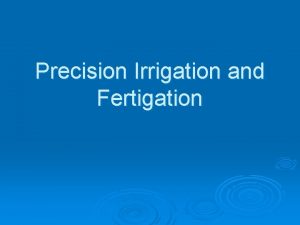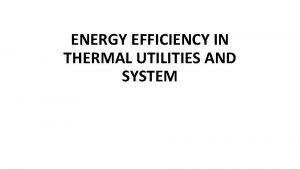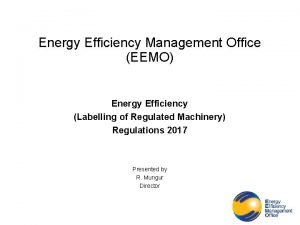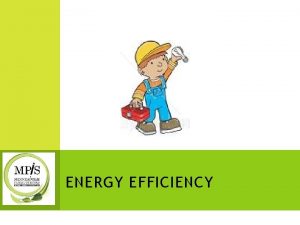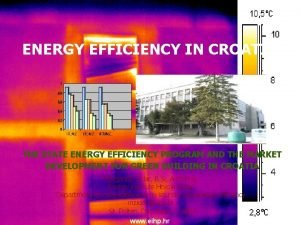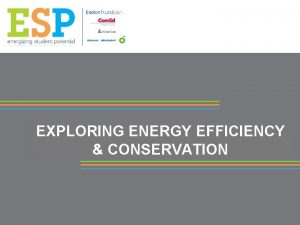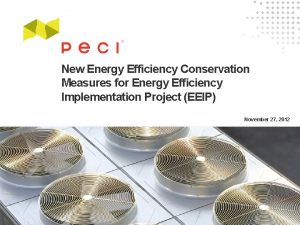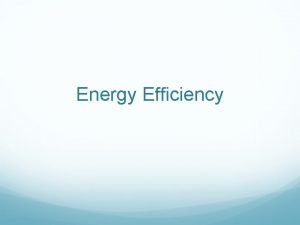Improved Precision Leading to Improved Energy Efficiency Edward

















- Slides: 17

Improved Precision Leading to Improved Energy Efficiency Edward Decker AE 790 – Intelligent Buildings June 6, 2006

Why is Ventilation Air Needed? § The health and comfort of the building occupants § The removal of internally generated contaminants § To maintain certain pressure differentials between the indoor and outdoor environments

How to Ensure Proper Ventilation § Use a dedicated OA system – Provides 100% OA – Ensures the minimum ventilation requirements are met § Why Not? – No mixing of Airstreams § 100% of the SA must be conditioned § Increased energy use – Increased energy cost – Best to maximize return air

How is RA & OA Mixed § Dampers are modulated to allow for air to be directed – Back in to the AHU as RA – Out of the building into the atmosphere as EA § Mass Balance – The amount of EA needs to be replaced § OA is introduced to the system via an OA damper § The amount of OA must meet the minimum requirements – The first step is to quantify the required and actual amounts of SA, RA, EA, and OA

What are the Methods to Measure Ventilation Air? § Direct – Measures the airflow directly, using a devise such as an anemometer. – Require regular flow profiles for accurate readings. § Indirect – Measures other parameters that are dependant upon the airflow, as in the energy balance method – Typically for low rates that are difficult to measure

What are the Ways to Measure Ventilation Air? § Direct – Averaging Pitot-Tube Array – Electronic Thermal Anemometry – Fan Inlet – Rotating vane and propeller anemometers – Swinging vane anemometers – Vortex shedding meters – Integrated damper and measuring devises – Laser doppler anemometry (LDA) – Orifice Meters § Indirect – Enthalpy Balance – Concentration Balance

Measuring Ventilation Air § Direct Method with Pitot-tube array – Velocity must be high enough for sensor accuracy – Regular flow profile is required, and often overlooked § Spacing of a minimum of 2 D before a station and 1 D behind required § Development of flow devices – Calculate properties of fully developed flow profile § Less space required – Device to ‘trip’ the velocity profile § Achieve accurate readings § Less space required – Comfortable Methods § Current Industry Standard without inherent problems

What are the Common ways to Control Ventilation Air? § Flow monitoring using: – Hot wire anemometers – Thermistor sensors – Velocity pressure sensing (pitot-tubes) § Differential Static Pressure Control – across fixed duct elements or with respect to OA pressure § Use of commissioning data to relate system flow at various fan-operating points with OA damper actuator signal position § Volumetric Fan tracking – Measuring SA and RA and assuming that the difference is the amount of OA § CO 2 surrogate sensing § Outside Air Injection Fan

Differential Static Pressure Control § Involves maintaining a constant pressure in the mixed air plenum or other reference point in the duct. – With constant pressure in the mixed air plenum and a fixed minimum damper, the minimum OA quantity remains constant as the supply air fan modulates. § Static pressure sensors are simple, reliable, and require little space.

Modulating minimum OA damper § New product such as flow sensing built into dampers may be the best – Velocity pressure is calculated and maintained constant by modulating the minimum OA blades themselves

Mixed Air Temperature Comparison Method § Method is still being used, but is not recommended – When OA and RA are within 10 -20 °F, readings are not trustworthy § Accuracy degrades as Toa approaches Tra – Balancers sometimes use this method when there isn’t room for pitot tube traverses

Mixed Air Temperature Comparison Method § Better Sensors can Improve this Technique – Cheaper Sensors § More sensors – Redundancy in readings – More Precise Sensors § Less errors in readings § Close OA and RA temperatures can be distinguished better

Concentration Balance § Provides adequate control – Exceptions § Low occupancy § When OA represents a small fraction of SA § Problems – Only accounts for contaminants generated by people in space, but not other contaminants § i. e. -VOCs from carpets, paints, etc

Concentration Balance § Better Sensors for measurement of all contaminants – OA might be polluted § Determine the airstream with the ‘best’ quality of air § Leads to improved overall IAQ – Multiple readings with improved precision § Can measure the air requirements of a given space § Design on an individual zone basis

Concentration Balance § Design on an Individual Zone Basis – Occupied modes for each zone – Ventilation requirements for individual room – Improved IAQ – Decreased energy consumption – Decreased energy bills

Conclusion § Accurate measurement and control of outside air intake is possible – Proper installation and operation § Intelligent Design – – Improve accuracy of readings and control More precise control § Better zone conditions – Improved overall IAQ – Energy savings – Cost Savings

QUESTIONS? ?
 Objectives of roving frame
Objectives of roving frame Inside micrometer least count
Inside micrometer least count Semi-precision attachment
Semi-precision attachment Bcd gösterimi
Bcd gösterimi Renewable energy and energy efficiency partnership
Renewable energy and energy efficiency partnership Opportunity cost formula
Opportunity cost formula Allocative efficiency vs productive efficiency
Allocative efficiency vs productive efficiency Productively efficient vs allocatively efficient
Productively efficient vs allocatively efficient Low energy precision application
Low energy precision application Energy energy transfer and general energy analysis
Energy energy transfer and general energy analysis Energy energy transfer and general energy analysis
Energy energy transfer and general energy analysis Saudi energy efficiency program
Saudi energy efficiency program Data center energy efficiency
Data center energy efficiency Energy efficiency in thermal utilities
Energy efficiency in thermal utilities Taiwan energy efficiency label
Taiwan energy efficiency label Energy efficiency management office
Energy efficiency management office Trophic level percentages
Trophic level percentages Sgip rebate step 6
Sgip rebate step 6








